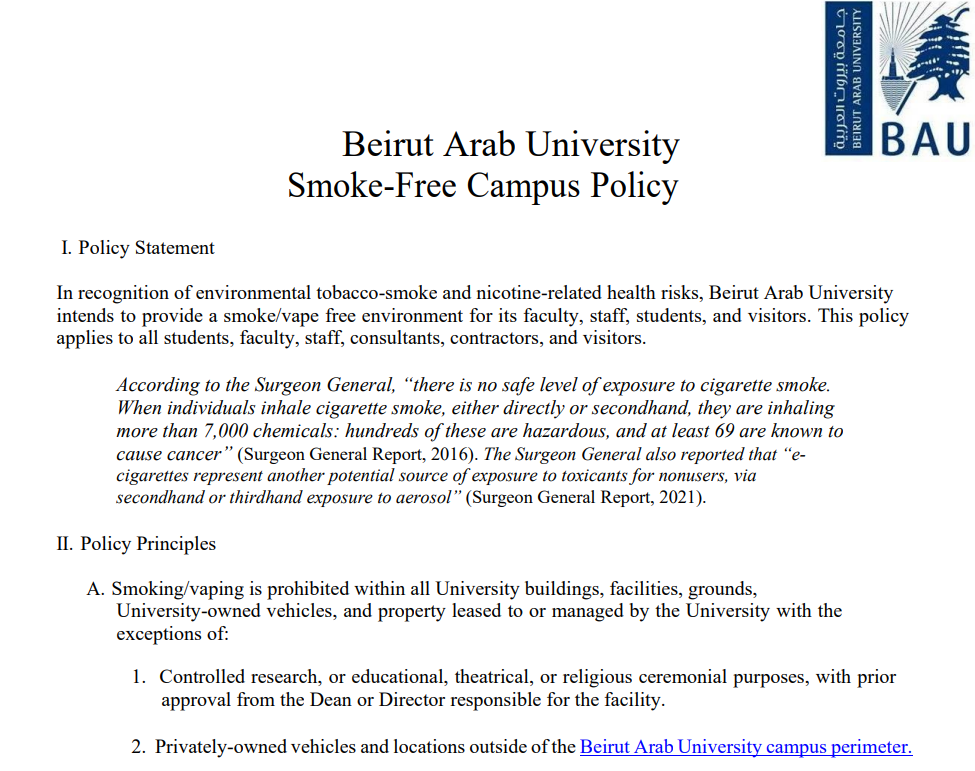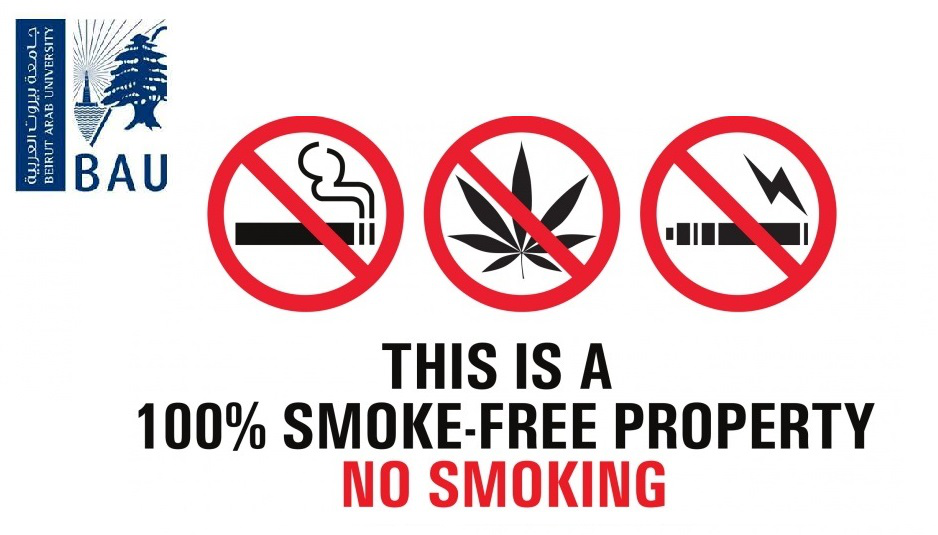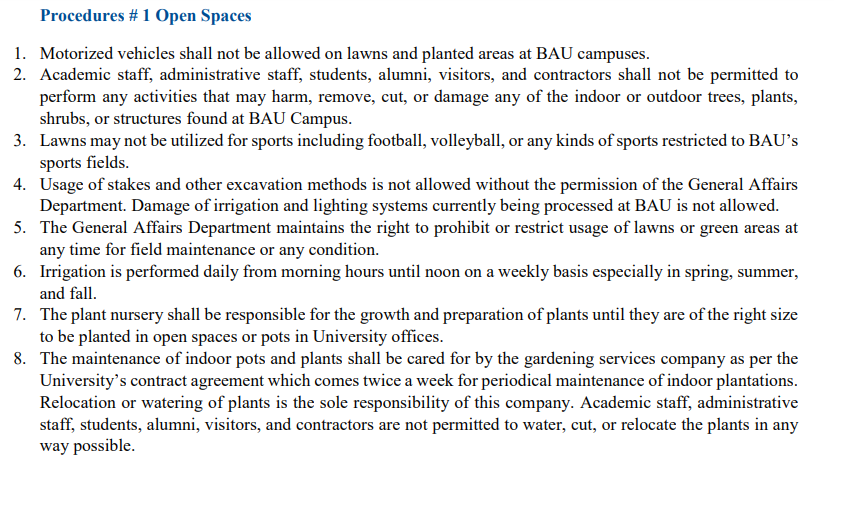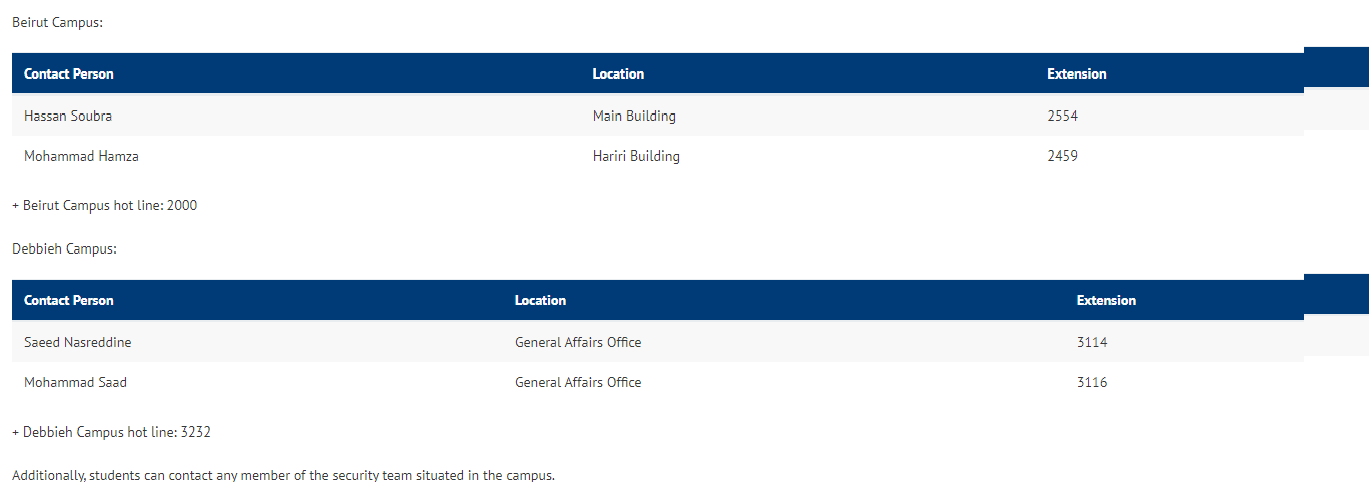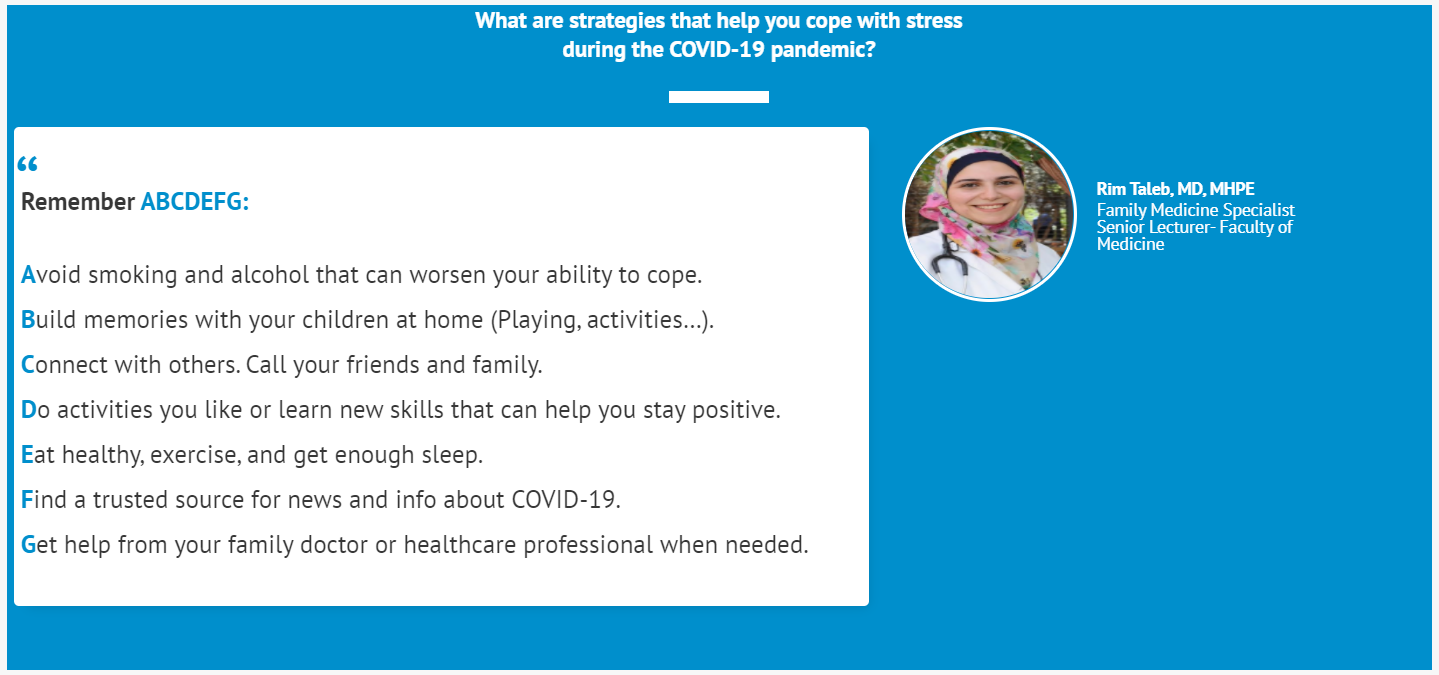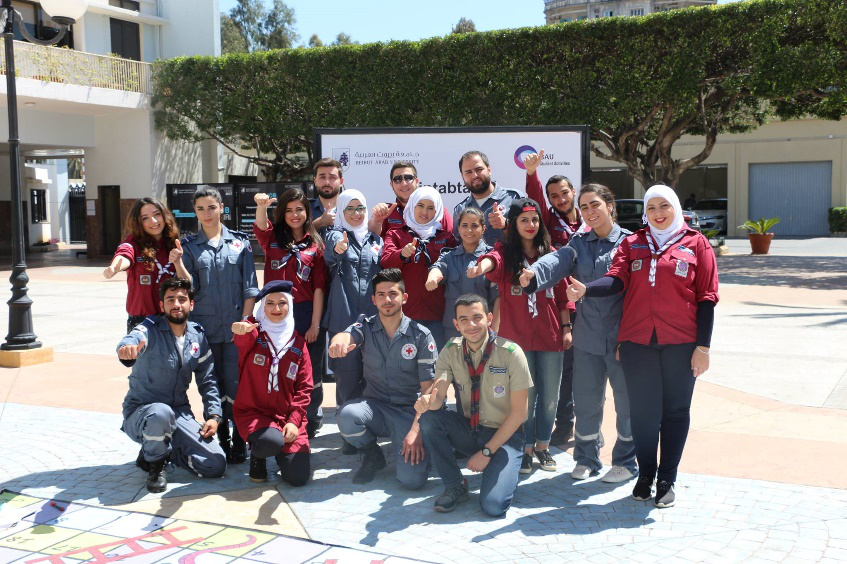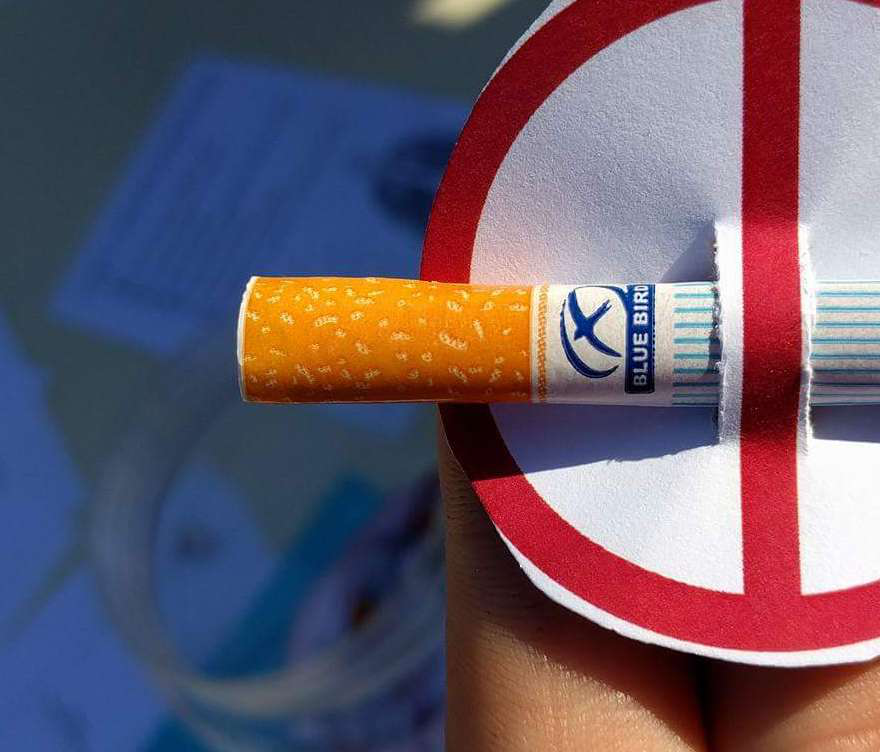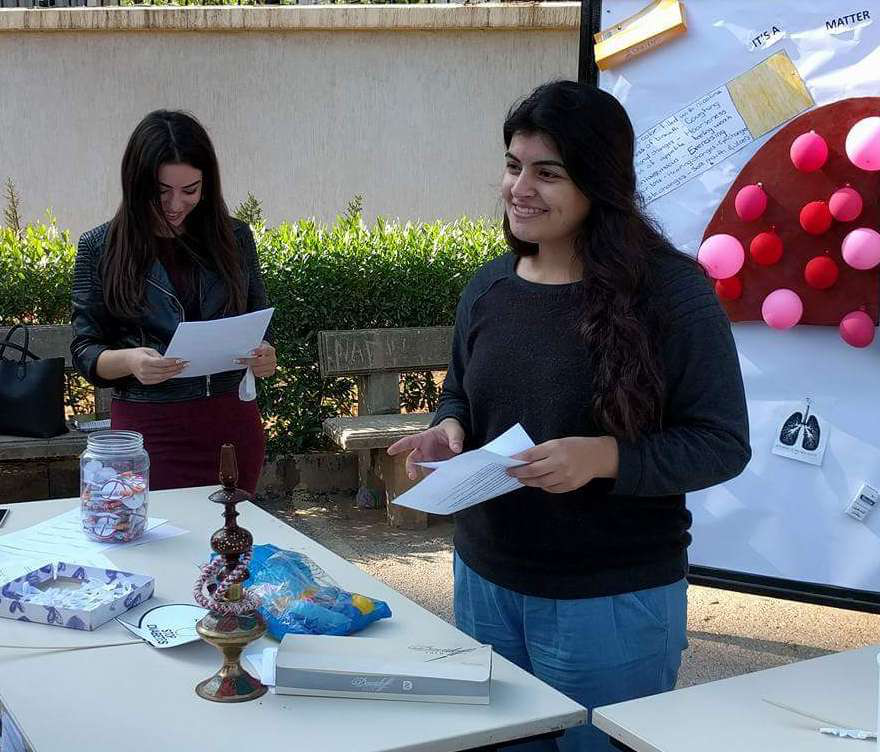University policy 'Smoke-free'
Beirut Arab University Smoke-Free Campus Policy – Policy Statement
In recognition of environmental tobacco-smoke and nicotine-related health risks, Beirut Arab University intends to provide a smoke/vape free environment for its faculty, staff, students, and visitors. This policy applies to all students, faculty, staff, consultants, contractors, and visitors.
Beirut Arab University Smoke-Free Campus Policy - Policy Principles
Smoking/vaping is prohibited within all University buildings, facilities, grounds, University-owned vehicles, and property leased to or managed by the University with the exceptions of:
Controlled research, or educational, theatrical, or religious ceremonial purposes, with prior approval from the Dean or director responsible for the facility.
Privately-owned vehicles and locations outside of the Beirut Arab University campus perimeter.
Littering the campus with remains of disposable tobacco/nicotine products is prohibited.
Assistance with smoking/vaping cessation for students, faculty and staff is available through the Beirut Arab University healthcare center. Information regarding smoking, vaping, and tobacco use at Beirut Arab University can be found within their Smoking Policy.
Beirut Arab University promotes the campus smoke free to contribute the health and well-being, so it makes it clear in its Smoke Police as it seeks the best for the academic community and staff. In this sense, BAU has taken the initiative to take care of its students and the environment, each decision has the purpose of achieving a smoke-free campus.
Any concerns about and/or violations of the policy will be brought to the attention of the individuals responsible for the operation of the University facility in question and/or the supervisor responsible for the work área.
Beirut Arab University encompasses various open spaces planted with different kinds of flowers, shrubs, and trees that include ficus trees, olive trees, eucalyptus trees, cypress trees, and ieland trees in addition to other trees spread around the University campuses.
Campus green areas are designed to allow for the provision of open spaces for the University community. It is vital that the University designates certain policies and procedures to maintain these spaces and avoid excessive damage. Periodic maintenance activities should be performed on a regular basis to insure the preservation of these open spaces.
Beirut Arab University Faculty of Medicine incorporated into the Lebanese Medical Students’ International Committee (LeMSIC) have organized a health campaign entitled “Diabetes, Epilepsy and Lung Cancer Awareness “. One in Six of Lebanese people has diabetes. The campaign’s goal and duty are to make the remaining five aware of the diabetic person’s case, symptoms and treatment.
The committee also oriented them about how to test one’s own blood for glucose levels, as well as the normal and abnormal findings. As for lung cancer, the students focused on smoking since it is the major cause of this type of cancer (more than 90% of lung cancer patients are smokers). The Committee has done that through a game: one of the public has to exchange a smoker’s cigarette with a gum cigarette .
BAU’s General Affairs and Services Department is concerned with all student emergency situations. Student can report using the hotlines in case of on-campus emergencies or situations occurring as a result of disasters such as earthquakes, fires, or floods [5].
The Lebanese Red Cross Youth Department, BAU Club, and the scouts club as part of the activities Department-Beirut campus organized on Wednesday 05/04/2017 starting from 10:00 AM an awareness campaign on the hazards of smoking at Beirut campus.
The campaign targeted about 50 students whose awareness was raised by demonstrating information about the dangers of smoking and its disadvantages. This object was attained by the means of conducting experiments and participating in informative games.
The students of the Faculty of Medicine, incorporated into the Lebanese Medical Students’ International Committee (LeMSIC) have organized a health campaign entitled “Diabetes, Epilepsy and Lung Cancer Awareness “on Tuesday 24/11/2015 in Main Building, Beirut Campus.
One in Six of Lebanese people has diabetes. The campaign’s goal and duty are to make the remaining five aware of the diabetic person’s case, symptoms and treatment. The committee also oriented them about how to test one’s own blood for glucose levels, as well as the normal and abnormal findings.
Epilepsy, was an odd topic for some of our public, many people have never heard about it before. That is why it was very crucial to organize such a campaign. The students taught the public about the disease, and explained why we should not discriminate against epileptic people. Moreover, the public was taught how to handle a situation during which a surrounding person encounters a seizure.
As for lung cancer, the students focused on smoking since it is the major cause of this type of cancer (more than 90% of lung cancer patients are smokers). The Committee has done that through a game: one of the public has to exchange a smoker’s cigarette with a gum cigarette.
The public was well satisfied with the knowledge they gained. Although it was a very sensitive and important bundle of information.
Food, Drinks and Smoking Guidelines
Smoking Is Not Allowed in The Library.
Snacks Are Not Allowed in The Library.
The Library Allows Covered Drink Cups.
Despite various strategies and efforts exerted in the form of awareness campaigns, health conferences, targeted advertisements and laws, the prevalence of smoking is alarmingly increasing for both genders in Lebanon. Because of the ease of accessibility, community pharmacists are ideally positioned to help their patients quit smoking. The current study aims to assess the Lebanese pharmacists’ practices in counseling their patients on smoking cessation.
A cross-sectional study targeting community pharmacists in Beirut was conducted during June 2017 to September 2017. The adopted questionnaire was designed based on the WHO approved 5A’s toolkit program for delivering brief tobacco interventions in primary care. Results were analyzed using the Statistical Package for Social Sciences program (SPSS) version 20 and Mega Stat. Our results showed that, for most of the survey questions, the performance of fresh pharmacy graduates (having less than 5 years of practice experience) and senior pharmacists (having 6-10 years of practice experience) with regards to counseling patients on smoking cessation using was not statistically different compared to that of older pharmacists (having more than 10 years of practice experience).
In a similar pattern to that obtained concerning the length of professional experience, the participating pharmacist in our study, irrespective to their graduating universities, displayed inconsistent practices during counselling their patients on smoking cessation. Interestingly, the presence of on-duty assistance to the participating pharmacists during their practice shift was shown to be significant (P< 0.05 for all questions) in helping them provide their smoking patients proper counselling on smoking cessation.
In conclusion, our study highlighted the discrepancy in the participating community pharmacists’ practices relevant to their ability to provide their smoking patients with appropriate smoking cessation services. In order to address the current situation, well-planned, structured interventions at both educational and professional levels should be made as a priority.
Shisha smoking is continuing to be a socially acceptable method of tobacco smoking especially in the young population worldwide. The objective of this study was to determine the effect of shisha smoking on pulmonary function tests (PFT) and its correlation with insomnia in Lebanon. 382 shisha-only smokers who are less than 50 years old were recruited. A questionnaire form including inquiry about some demographic data, shisha smoking history, level of physical activity and Pittsburgh sleep quality index (PSQI) was administered to the participants after signing an informed consent.
Forced expiratory volume at one second (FEV1), forced vital capacity (FVC), and FEV1/FVC ratio were recorded using a portable spirometer. More than half of the participants showed an abnormal pattern on spirometry. Two thirds of the participants showed a global PSQI score higher than 5 indicating poor sleep quality. Yet, no statistically significant values could be detected in relating longevity of shisha smoking, last time shisha has been smoked or duration of shisha smoking session and the presence of either abnormal patterns of PFT or poor sleep quality.
A statistically significant correlation showed only between the level of physical activity and normal PFT. Shisha-only smokers with frequent physical activity had significantly better PFT pattern than those with no physical activity (P<0.011). In conclusion, this study suggests that in population younger than 50 years old, shisha smoking seems not as harmful as widely believed especially in regards to lung functions and insomnia. Physical activity is a positive predictor of normal PFT.
People, especially at early age, start smoking due to peer pressure, smokers in the surrounding including the family, to relax and relieve from boredom or stress, to look cool and trendy in front of the others. Therefore, the strong and the smart ones are not influenced easily by the surroundings and are able to say no to smoking!
As for those who already smoke, many of them want to stop this habit. Quitting is not an easy option and many attempts can fail. However, stopping is very beneficial since it reduces the risk of developing the mentioned diseases above. In order to stop, many methods/tips can be helpful:
Commitment is half way for success
The 4 D’s to help get through a craving
Delay the time you crave a cigarette, the urge to smoke will fade in few minutes
Drink water by holding it in the mouth for a while
Deep and slow breathing in and out for 5 times
Distract yourself with a friend or an activity to forget smoking for these few minutes
Cold Turkey such as immediate quitting or gradual reduction with no outside help/therapy/medications.
Nicotine Replacement Therapy such as nicotine gum and inhalers. These are nicotine products excluding tobacco. However, the point with quitting is to end nicotine addiction, not to simply stop using tobacco products but it can be a good start.
Behavior Therapy where the counselor makes a plan to change this habit or to manipulate the conditions that trigger smoking
Prescribed medication in case of significant difficulties and symptoms from withdrawal
Lastly, using a combination of these methods increases the chance of successful quitting. If you are a smoker and you are reading this, think about it and start today... After all, you are doing it for your health and the health of your loved ones!
Abstract
The American Heart Association has published a scientific statement on the effect of hookah smoking on health outcomes; nevertheless, hookah smoking continues to be popular worldwide, especially among the young. Recent reports mention a potential link between hookah smoking and obesity; however, uncertainties still surround this issue.
The aim of the current study was to conduct a systematic review to clarify whether hookah smoking is associated with a higher risk of obesity among the general population. This study was conducted in compliance with the preferred reporting items for systematic reviews and meta-analyses (PRISMA) guidelines, and data were collated by means of a meta-analysis and a narrative synthesis.
Of the 818 articles retrieved, five large-population and low-bias studies comprising a total of 16,779 participants met the inclusion criteria and were reviewed. All included studies reported that, regardless of gender, hookah smoking increases the risk of obesity among all ages and observed an association between the two after a correction for several confounders or reported a higher prevalence of obesity among hookah smokers.
This was confirmed by the meta-analysis. Therefore, hookah smoking seems to be associated with a higher risk of obesity. Public health policymakers should be aware of this for the better management of obesity and weight-related comorbidities.
Author(s): Marwan Ibrahim El Ghoch
Coauthor(s): Dana El Masri, Hana Tannit, Dima Kreidieh , Leila Itani
Journal/Conference Information: Journal of Cardiovascular Development and Disease ,DOI: doi.org/10.3390/jcdd6020023 , ISSN: 2308-3425, Volume: 6, Issue: 2, Pages Range: 1-11,
